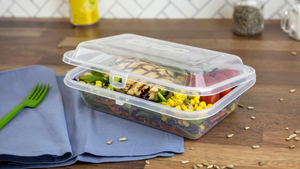Material solutions help spur innovation in automotive parts
A tour of the mini-expo colocated with the “Plastics in automobile engineering” event in Mannheim, Germany last month made clear that materials suppliers continue to aggressively develop new solutions for automotive applications. For instance BASF (Ludwigshafen, Germany), made a splash when it announced that Bosch is molding the supplier’s Ultraform N2320 C, a carbon nanotube (CNT)-filled polyacetal (POM), into a fuel filter housing for the Audi A4 and A5 from Bosch’s facility in Budweis, Czech Republic.
April 24, 2009
A tour of the mini-expo colocated with the “Plastics in automobile engineering” event in Mannheim, Germany last month made clear that materials suppliers continue to aggressively develop new solutions for automotive applications. For instance BASF (Ludwigshafen, Germany), made a splash when it announced that Bosch is molding the supplier’s Ultraform N2320 C, a carbon nanotube (CNT)-filled polyacetal (POM), into a fuel filter housing for the Audi A4 and A5 from Bosch’s facility in Budweis, Czech Republic. This is the first commercial application for this material, which, thanks to the CNTs, offers a high degree of electrical conductivity; the N2320 C material has a specific volume resistance of just 30 ohm-cm. BASF claims the material retains POM’s toughness and dimensional stability, while costing less than other conductive compounds.
|
Thomas Ross, marketing manager, automotive, at polyolefinic foam supplier Sekisui Alveo (Lucerne, Switzerland), says the company has broken into the armrest market, replacing polyurethane (PUR) foam in passenger door armrests on the VW Tigran, with the material also now being introduced in the Golf VI, proving that a soft foam can be economical enough even for middle-class cars. The armrest has a 6mm-thick-polyolefin foam pad, also replacing PUR.
Usually a relatively complicated process is needed for these parts, with PUR foamed between the carrier, in this case a press-formed natural fiber/PP, and a fabric cover. Sekisui Alveo co-developed, with a machine manufacturer, a machine and process for forming these armrests in a single step on a simple compression molding machine. Ross says feedback has been positive, especially from manufacturers of compact or midsized cars. A compact Ford (he won’t specify yet which one) will soon use it, and the next generation of the VW Sharon family van will too. The target market, he says, is those cars where until now, hard foam has been used, a range encompassing cars from the low-end Opel Corsa to the Mercedes C-Class sedans. “The trick is we’ll have the same density but a much softer foam,” claims Ross.
Plastics supplier Borealis (Vienna, Austria) made two major introductions at this event: the world’s first air intake manifold molded of PP (replacing PA, which itself has been replacing metal in this application for 20 years), and an injection molded rear seat carrier of the firm’s Xmod GD302HP for the BMW 7 series sedans. Harold Hammer, VP mobility at Borealis, says the grade of PP used on the air intake manifold, the company’s Xmod GB306SAF short glass fiber reinforced PP, can be molded on tooling designed for polyamide, with minor changes to the entire process. Mahle is injection molding the manifolds for VW and reports a 15% weight savings, better acoustic behavior, and lower production costs.
On the BMW rear seat carrier another metal replacement scenario, circa 30% weight savings, is realized. The BMW 5 series cars also will start using this material this year in its rear seat carriers. The material is “a blend of PPs which cannot be pultruded,” a jab at long fiber-reinforced PP materials such as Sabic’s Stamax that are made via pultrusion. The Borealis material has lower emissions than LGF-PP, he says.
In a move to offer better scratch resistance for interior applications than established materials such as PP, PA/ABS or ABS, Dow Automotive (Auburn Hills, MI) developed its Velvex material, a reinforced elastomer for unpainted interior trim. The supplier compounds color into the material. Dow officials at the event would offer no hints as to the identity of the elastomer used, other than to say it was one of Dow’s current offerings that has been optimized for these applications.
Gloss levels on parts molded of the material are about 1.5, comparable to painted parts. It will cost slightly more than talc-filled PP but offer significantly higher scratch resistance, they said. Because it is olefin-based, they say it also offers better sound absorption qualities compared to ABS. —[email protected]
About the Author(s)
You May Also Like




